TOYOTA BZ4X 2022 Owners Manual (in English)
Manufacturer: TOYOTA, Model Year: 2022, Model line: BZ4X, Model: TOYOTA BZ4X 2022Pages: 674, PDF Size: 120.02 MB
Page 91 of 674
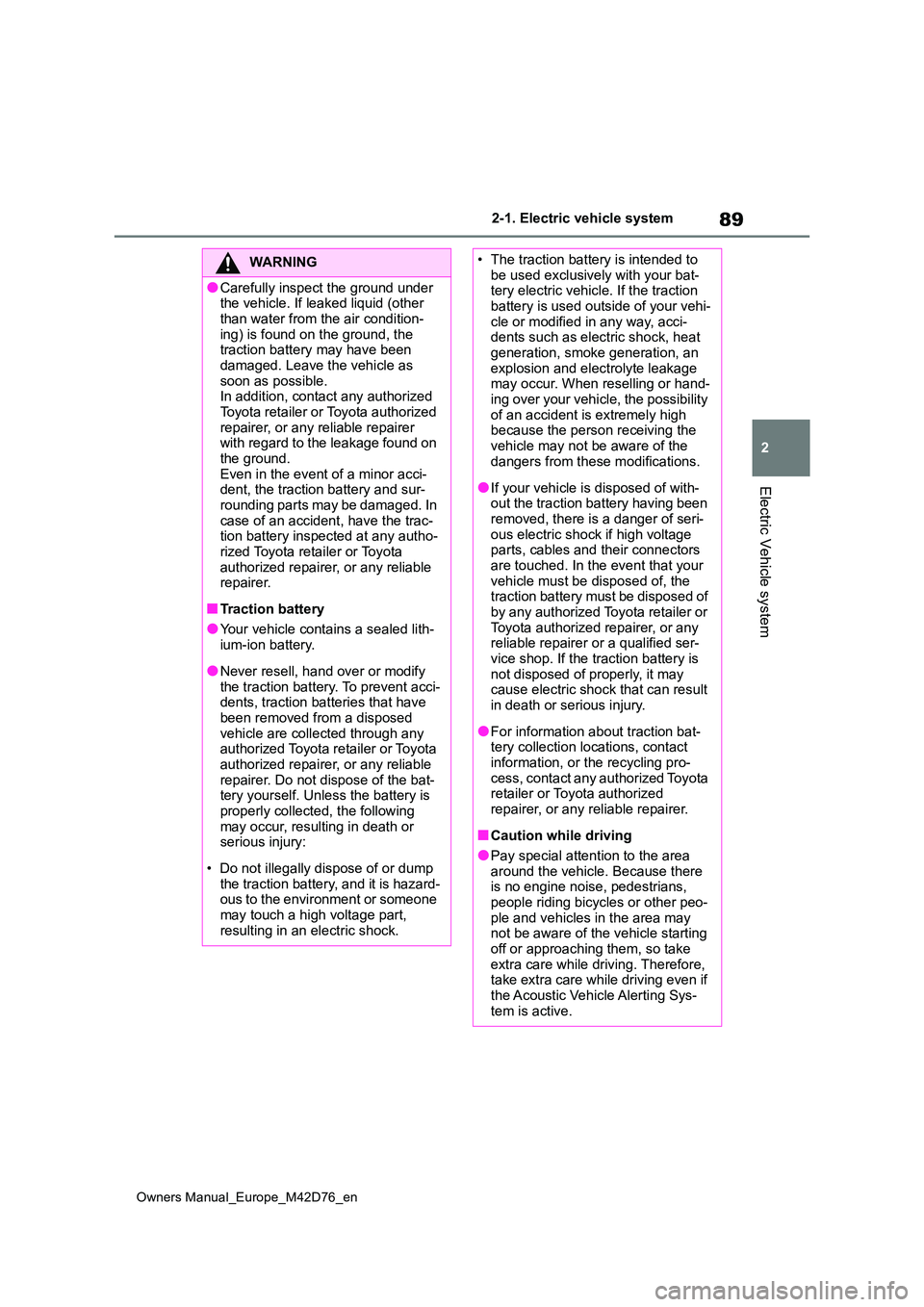
89
2
Owners Manual_Europe_M42D76_en
2-1. Electric vehicle system
Electric Vehicle system
WARNING
●Carefully inspect the ground under the vehicle. If leaked liquid (other
than water from the air condition- ing) is found on the ground, the traction battery may have been
damaged. Leave the vehicle as soon as possible. In addition, contact any authorized
Toyota retailer or Toyota authorized repairer, or any reliable repairer with regard to the leakage found on
the ground. Even in the event of a minor acci-dent, the traction battery and sur-
rounding parts may be damaged. In case of an accident, have the trac-tion battery inspected at any autho-
rized Toyota retailer or Toyota authorized repairer, or any reliable repairer.
■Traction battery
●Your vehicle contains a sealed lith-
ium-ion battery.
●Never resell, hand over or modify
the traction battery. To prevent acci- dents, traction batteries that have been removed from a disposed
vehicle are collected through any authorized Toyota retailer or Toyota authorized repairer, or any reliable
repairer. Do not dispose of the bat- tery yourself. Unless the battery is properly collected, the following
may occur, resulting in death or serious injury:
• Do not illegally dispose of or dump the traction battery, and it is hazard-ous to the environment or someone
may touch a high voltage part, resulting in an electric shock.
• The traction battery is intended to be used exclusively with your bat-tery electric vehicle. If the traction
battery is used outside of your vehi- cle or modified in any way, acci-dents such as electric shock, heat
generation, smoke generation, an explosion and electrolyte leakage may occur. When reselling or hand-
ing over your vehicle, the possibility of an accident is extremely high because the person receiving the
vehicle may not be aware of the dangers from these modifications.
●If your vehicle is disposed of with-out the traction battery having been removed, there is a danger of seri-
ous electric shock if high voltage parts, cables and their connectors are touched. In the event that your
vehicle must be disposed of, the traction battery must be disposed of by any authorized Toyota retailer or
Toyota authorized repairer, or any reliable repairer or a qualified ser-vice shop. If the traction battery is
not disposed of properly, it may cause electric shock that can result in death or serious injury.
●For information about traction bat-tery collection locations, contact
information, or the recycling pro- cess, contact any authorized Toyota retailer or Toyota authorized
repairer, or any reliable repairer.
■Caution while driving
●Pay special attention to the area around the vehicle. Because there is no engine noise, pedestrians,
people riding bicycles or other peo- ple and vehicles in the area may not be aware of the vehicle starting
off or approaching them, so take extra care while driving. Therefore, take extra care while driving even if
the Acoustic Vehicle Alerting Sys- tem is active.
Page 92 of 674
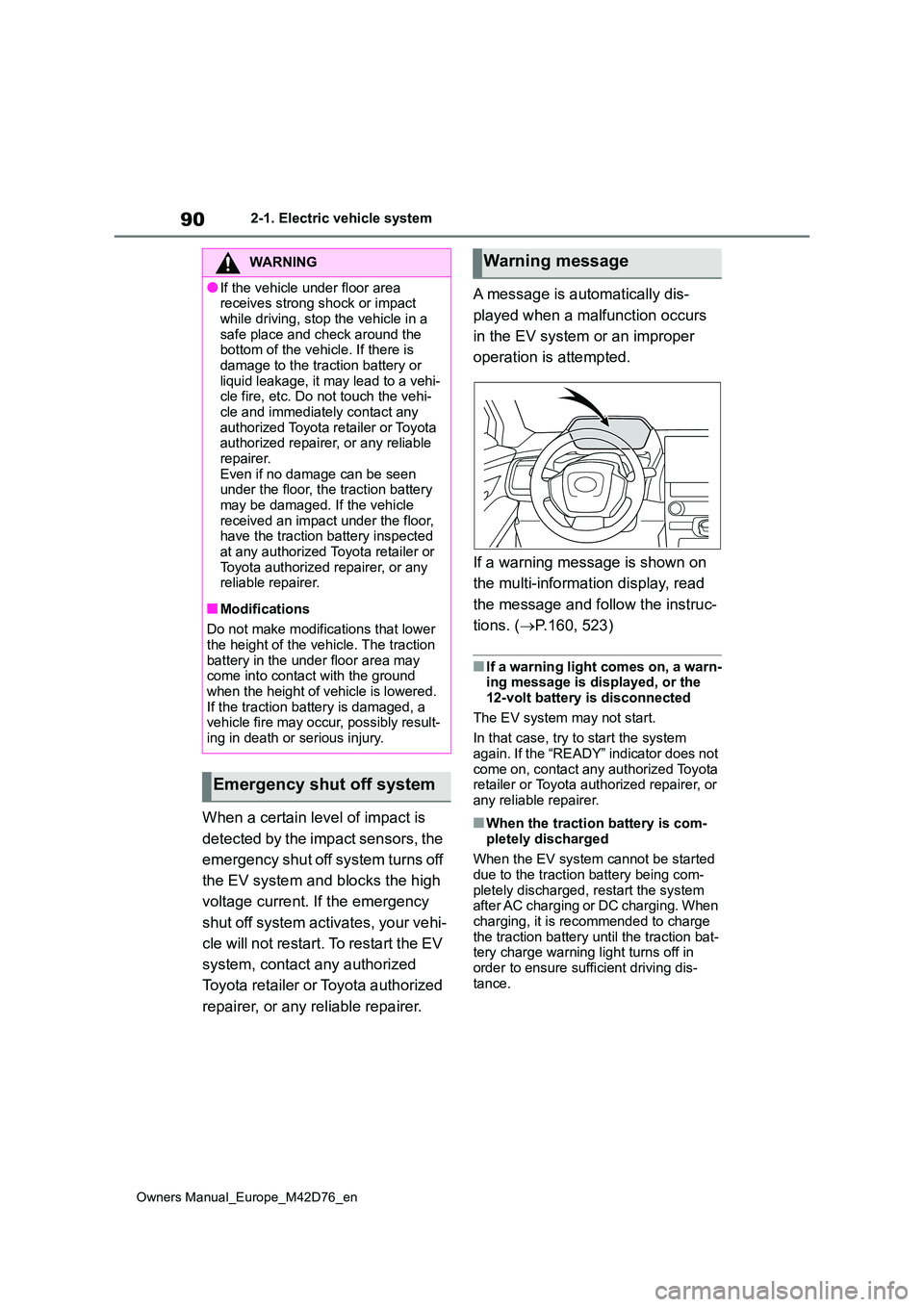
90
Owners Manual_Europe_M42D76_en
2-1. Electric vehicle system
When a certain level of impact is
detected by the impact sensors, the
emergency shut off system turns off
the EV system and blocks the high
voltage current. If the emergency
shut off system activates, your vehi-
cle will not restart. To restart the EV
system, contact any authorized
Toyota retailer or Toyota authorized
repairer, or any reliable repairer.
A message is automatically dis-
played when a malfunction occurs
in the EV system or an improper
operation is attempted.
If a warning message is shown on
the multi-information display, read
the message and follow the instruc-
tions. ( P.160, 523)
■If a warning light comes on, a warn- ing message is displayed, or the 12-volt battery is disconnected
The EV system may not start.
In that case, try to start the system again. If the “READY” indicator does not
come on, contact any authorized Toyota retailer or Toyota authorized repairer, or any reliable repairer.
■When the traction battery is com-
pletely discharged
When the EV system cannot be started due to the traction battery being com-
pletely discharged, restart the system after AC charging or DC charging. When
charging, it is recommended to charge the traction battery until the traction bat-tery charge warning light turns off in
order to ensure sufficient driving dis- tance.
WARNING
●If the vehicle under floor area receives strong shock or impact
while driving, stop the vehicle in a safe place and check around the bottom of the vehicle. If there is
damage to the traction battery or liquid leakage, it may lead to a vehi-cle fire, etc. Do not touch the vehi-
cle and immediately contact any authorized Toyota retailer or Toyota authorized repairer, or any reliable
repairer. Even if no damage can be seen under the floor, the traction battery
may be damaged. If the vehicle received an impact under the floor, have the traction battery inspected
at any authorized Toyota retailer or Toyota authorized repairer, or any reliable repairer.
■Modifications
Do not make modifications that lower
the height of the vehicle. The traction battery in the under floor area may come into contact with the ground
when the height of vehicle is lowered. If the traction battery is damaged, a vehicle fire may occur, possibly result-
ing in death or serious injury.
Emergency shut off system
Warning message
Page 93 of 674

91
2
Owners Manual_Europe_M42D76_en
2-1. Electric vehicle system
Electric Vehicle system
Shift the shift position to D when
stopped at a traffic light, or driving
in heavy traffic, etc. Shift the shift
position to P when parking. When
shifting the shift position to N while
driving, there is no positive effect
on electricity consumption. In the N,
the traction battery cannot be
charged. Also, when using the air
conditioning system, etc., the trac-
tion battery electricity is consumed.
( P.248)
Repeated acceleration and decel-
eration due to traffic congestion,
long waits at traffic lights, and driv-
ing on steep inclines will lead to
poor electricity consumption. In
order to avoid those situations as
much as possible, check traffic
reports before leaving. If the vehicle
is driven in traffic congestion, gently
release the brake pedal to allow the
vehicle to move forward slightly,
avoid overuse of the accelerator
pedal. Doing so can help minimize
unnecessary electricity consump-
tion.
Make sure to operate the brakes
gently and a timely manner. A
greater amount of electrical energy
can be regenerated when slowing
down.
Control and maintain the vehicle at
a constant speed. Before stopping
at a toll booth or similar, allow
plenty of time to release the accel-
erator and gently apply the brakes.
A greater amount of electrical
energy can be regenerated when
slowing down.
Batter y Electric Vehicle
driving tips
Unlike the conventional vehi-
cles, the electricity consump-
tion efficiency of battery
electric vehicles will decline if
they continue driving on high-
ways (or freeways) or at high
average speeds, causing the
possible driving distance to
reduce. Therefore, if the
remaining charge of the trac-
tion battery is low, avoid rely-
ing on the displayed possible
driving distance too much as
well as driving on highways (or
freeways). Driving the vehicle
at moderate speeds, the trac-
tion battery’s electricity con-
sumption can be controlled.
The following driving tips will
contribute to reduction in the
battery consumption and
increase in the driving range.
Shift position operation
Delays
When braking
Highway (or freeways) driv-
ing
Page 94 of 674
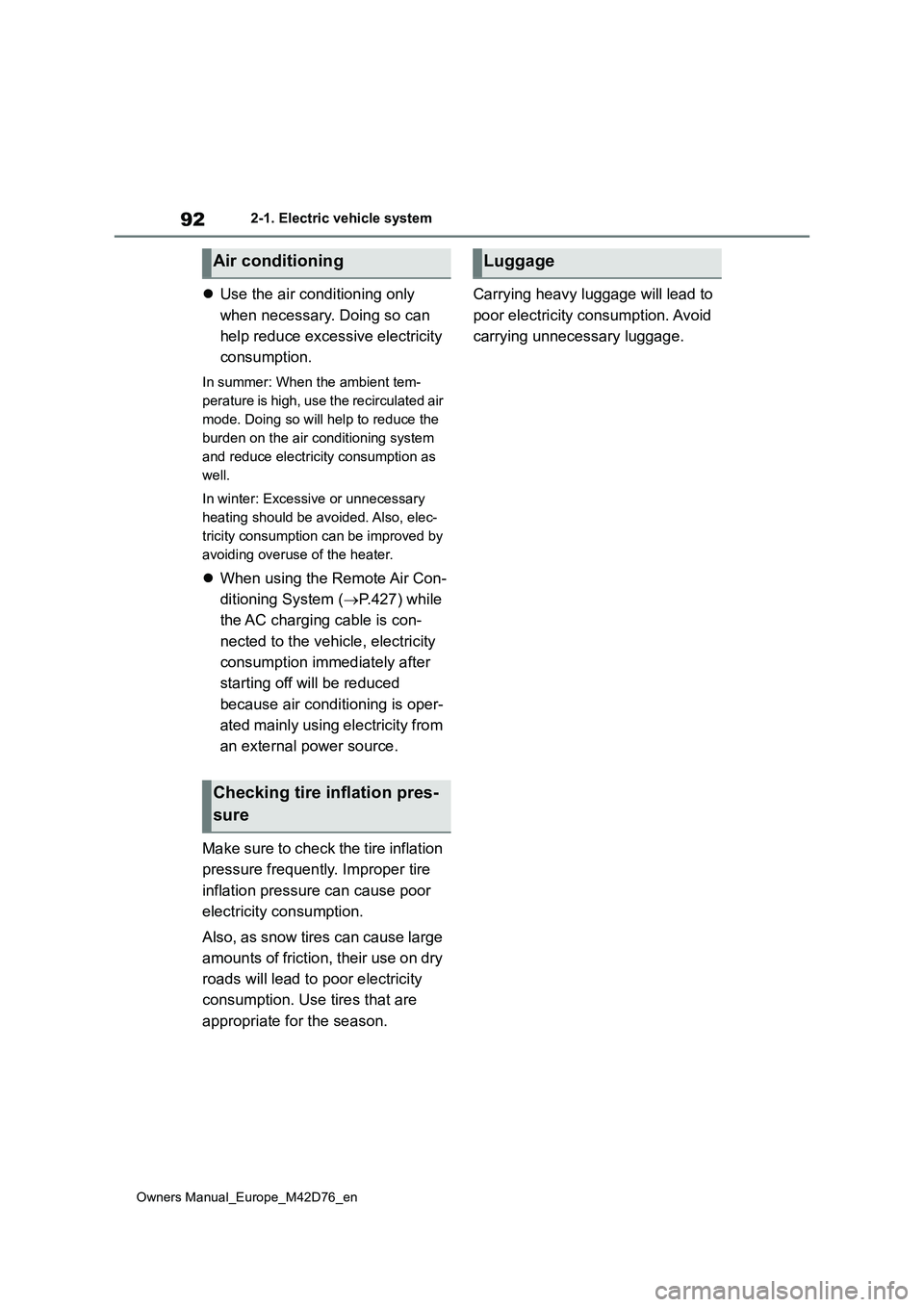
92
Owners Manual_Europe_M42D76_en
2-1. Electric vehicle system
Use the air conditioning only
when necessary. Doing so can
help reduce excessive electricity
consumption.
In summer: When the ambient tem-
perature is high, use the recirculated air
mode. Doing so will help to reduce the
burden on the air conditioning system
and reduce electricity consumption as
well.
In winter: Excessive or unnecessary
heating should be avoided. Also, elec-
tricity consumption can be improved by
avoiding overuse of the heater.
When using the Remote Air Con-
ditioning System ( P.427) while
the AC charging cable is con-
nected to the vehicle, electricity
consumption immediately after
starting off will be reduced
because air conditioning is oper-
ated mainly using electricity from
an external power source.
Make sure to check the tire inflation
pressure frequently. Improper tire
inflation pressure can cause poor
electricity consumption.
Also, as snow tires can cause large
amounts of friction, their use on dry
roads will lead to poor electricity
consumption. Use tires that are
appropriate for the season.
Carrying heavy luggage will lead to
poor electricity consumption. Avoid
carrying unnecessary luggage.
Air conditioning
Checking tire inflation pres-
sure
Luggage
Page 95 of 674
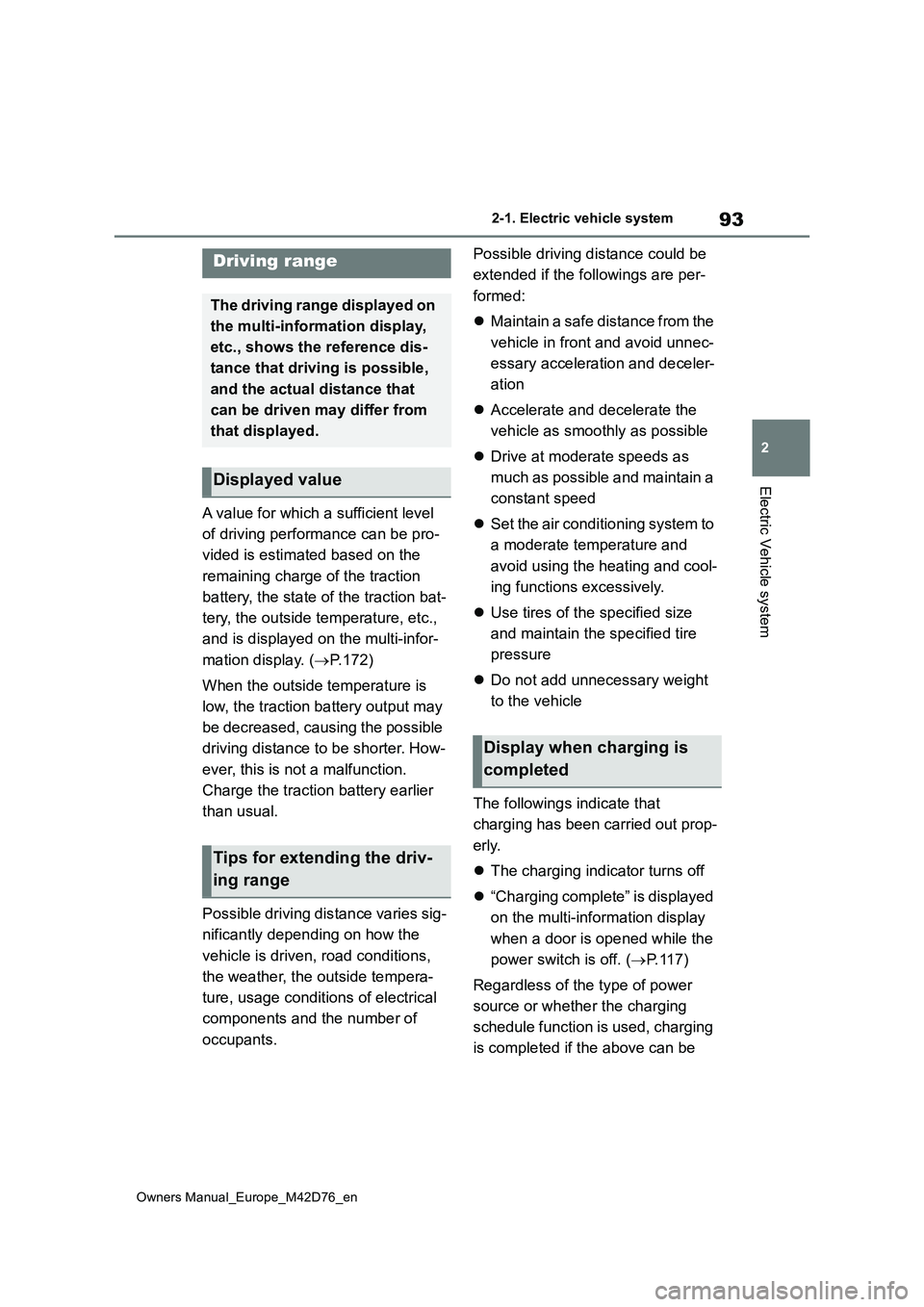
93
2
Owners Manual_Europe_M42D76_en
2-1. Electric vehicle system
Electric Vehicle system
A value for which a sufficient level
of driving performance can be pro-
vided is estimated based on the
remaining charge of the traction
battery, the state of the traction bat-
tery, the outside temperature, etc.,
and is displayed on the multi-infor-
mation display. ( P.172)
When the outside temperature is
low, the traction battery output may
be decreased, causing the possible
driving distance to be shorter. How-
ever, this is not a malfunction.
Charge the traction battery earlier
than usual.
Possible driving distance varies sig-
nificantly depending on how the
vehicle is driven, road conditions,
the weather, the outside tempera-
ture, usage conditions of electrical
components and the number of
occupants.
Possible driving distance could be
extended if the followings are per-
formed:
Maintain a safe distance from the
vehicle in front and avoid unnec-
essary acceleration and deceler-
ation
Accelerate and decelerate the
vehicle as smoothly as possible
Drive at moderate speeds as
much as possible and maintain a
constant speed
Set the air conditioning system to
a moderate temperature and
avoid using the heating and cool-
ing functions excessively.
Use tires of the specified size
and maintain the specified tire
pressure
Do not add unnecessary weight
to the vehicle
The followings indicate that
charging has been carried out prop-
erly.
The charging indicator turns off
“Charging complete” is displayed
on the multi-information display
when a door is opened while the
power switch is off. ( P.117)
Regardless of the type of power
source or whether the charging
schedule function is used, charging
is completed if the above can be
Driving range
The driving range displayed on
the multi-information display,
etc., shows the reference dis-
tance that driving is possible,
and the actual distance that
can be driven may differ from
that displayed.
Displayed value
Tips for extending the driv-
ing range
Display when charging is
completed
Page 96 of 674
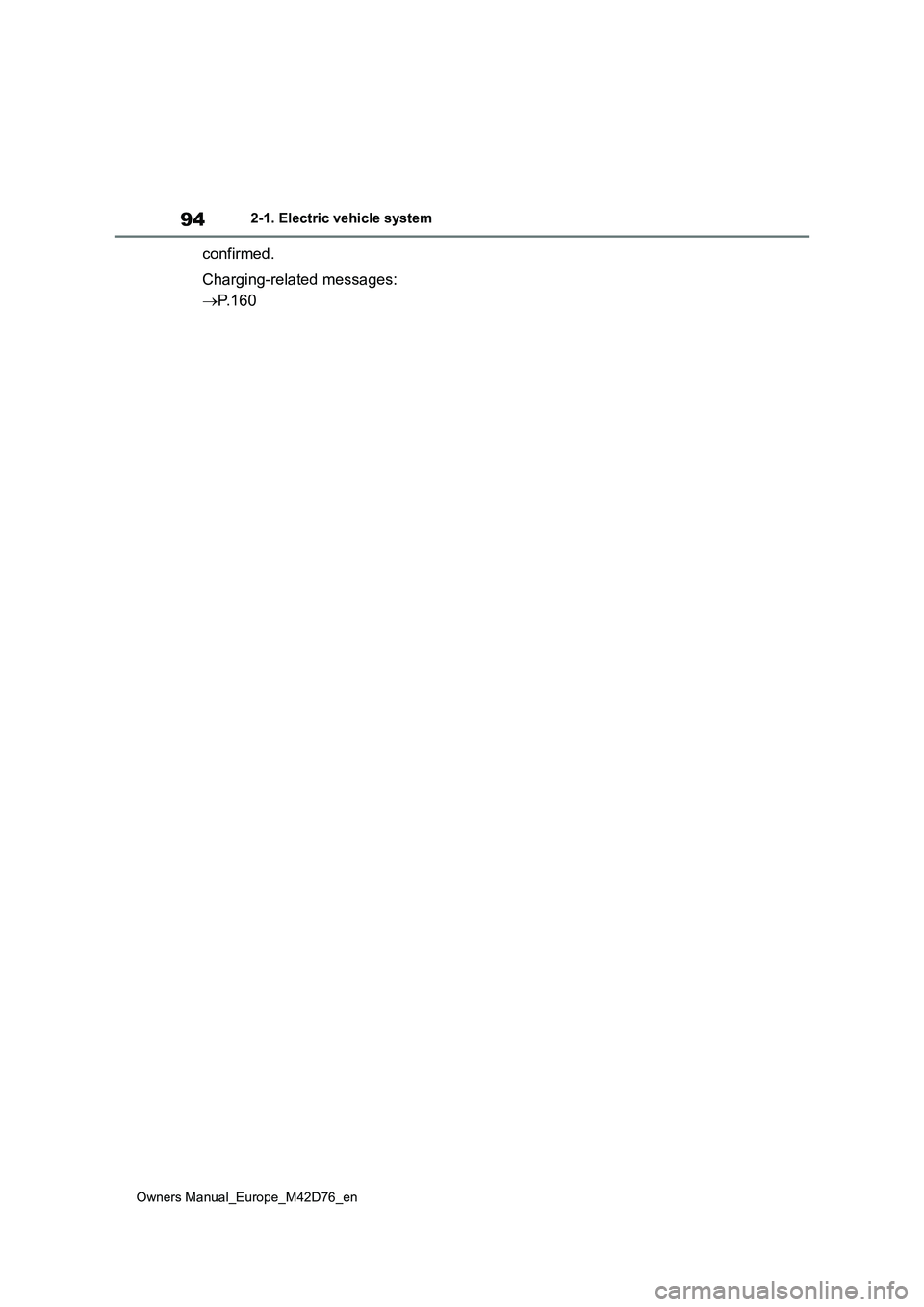
94
Owners Manual_Europe_M42D76_en
2-1. Electric vehicle system
confirmed.
Charging-related messages:
P. 1 6 0
Page 97 of 674
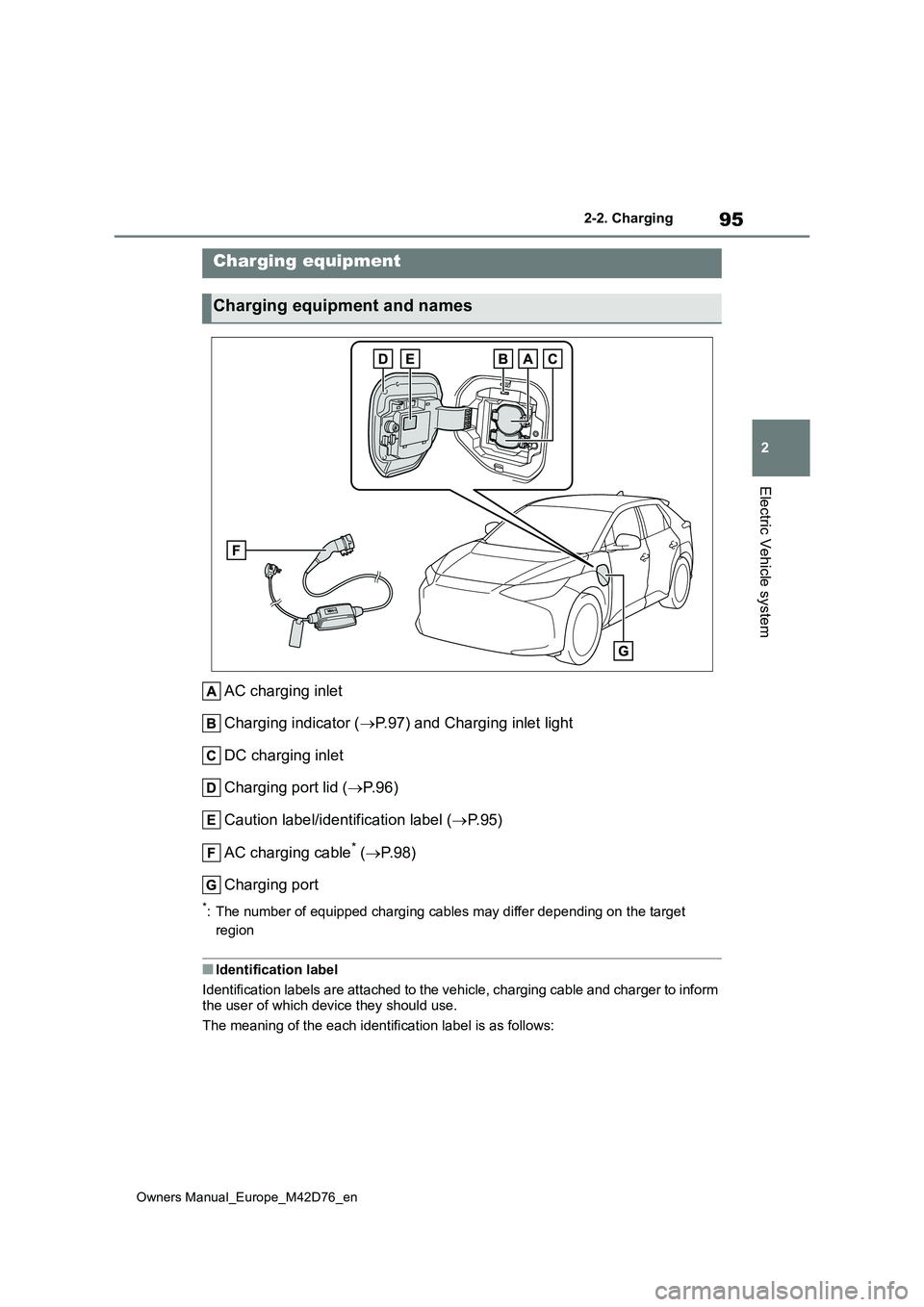
95
2
Owners Manual_Europe_M42D76_en
2-2. Charging
Electric Vehicle system
2-2.Charging
AC charging inlet
Charging indicator ( P.97) and Charging inlet light
DC charging inlet
Charging port lid ( P. 9 6 )
Caution label/identification label ( P.95)
AC charging cable* ( P.98)
Charging port
*: The number of equipped charging cables may differ depending on the target
region
■Identification label
Identification labels are attached to the vehicle, charging cab le and charger to inform
the user of which device they should use.
The meaning of the each identification label is as follows:
Charging equipment
Charging equipment and names
Page 98 of 674
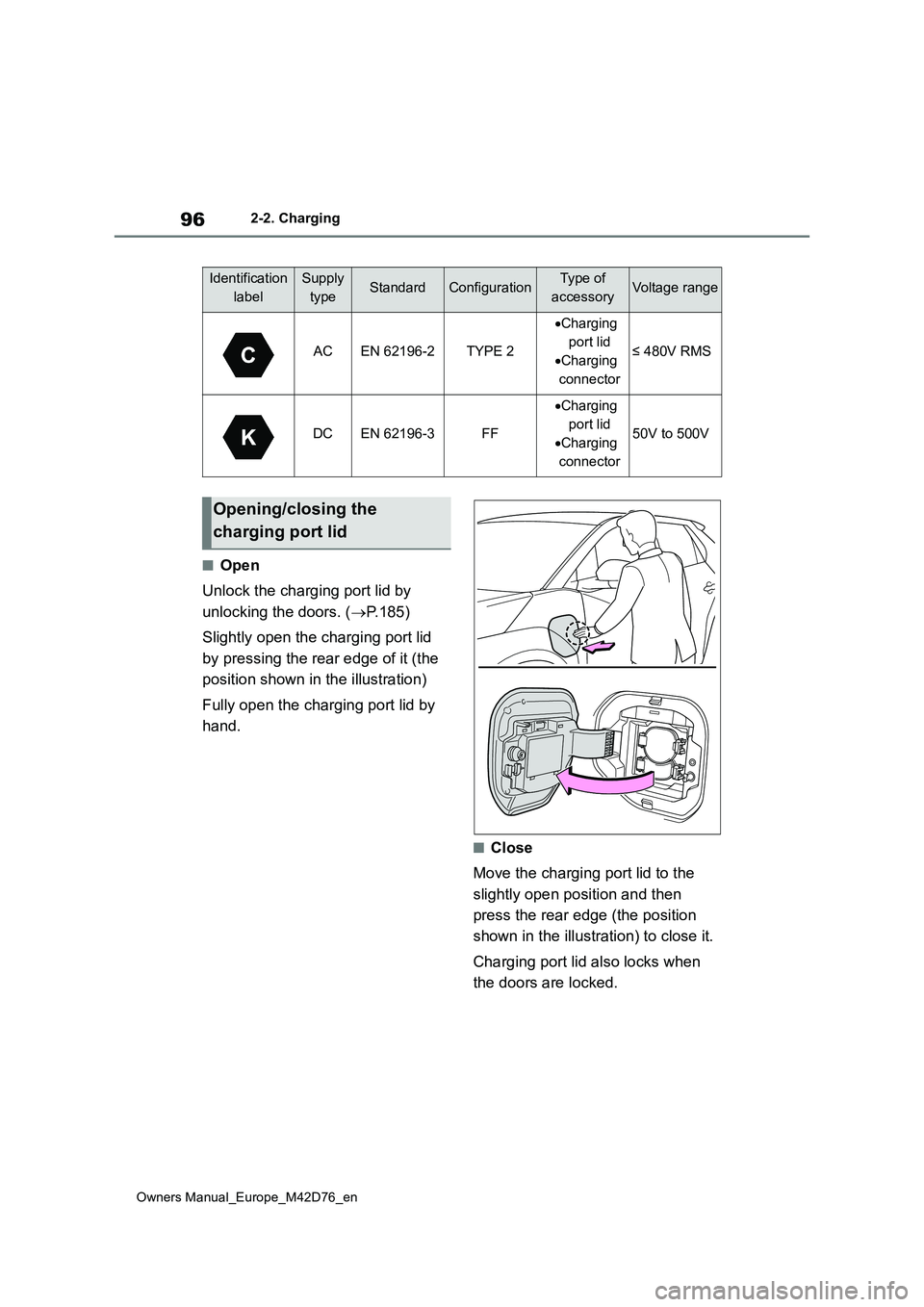
96
Owners Manual_Europe_M42D76_en
2-2. Charging
■Open
Unlock the charging port lid by
unlocking the doors. ( P.185)
Slightly open the charging port lid
by pressing the rear edge of it (the
position shown in the illustration)
Fully open the charging port lid by
hand.
■Close
Move the charging port lid to the
slightly open position and then
press the rear edge (the position
shown in the illustration) to close it.
Charging port lid also locks when
the doors are locked.
Identification
label
Supply
typeStandardConfigurationType of
accessoryVoltage range
ACEN 62196-2TYPE 2
Charging
port lid
Charging
connector
≤ 480V RMS
DCEN 62196-3FF
Charging
port lid
Charging
connector
50V to 500V
Opening/closing the
charging port lid
Page 99 of 674
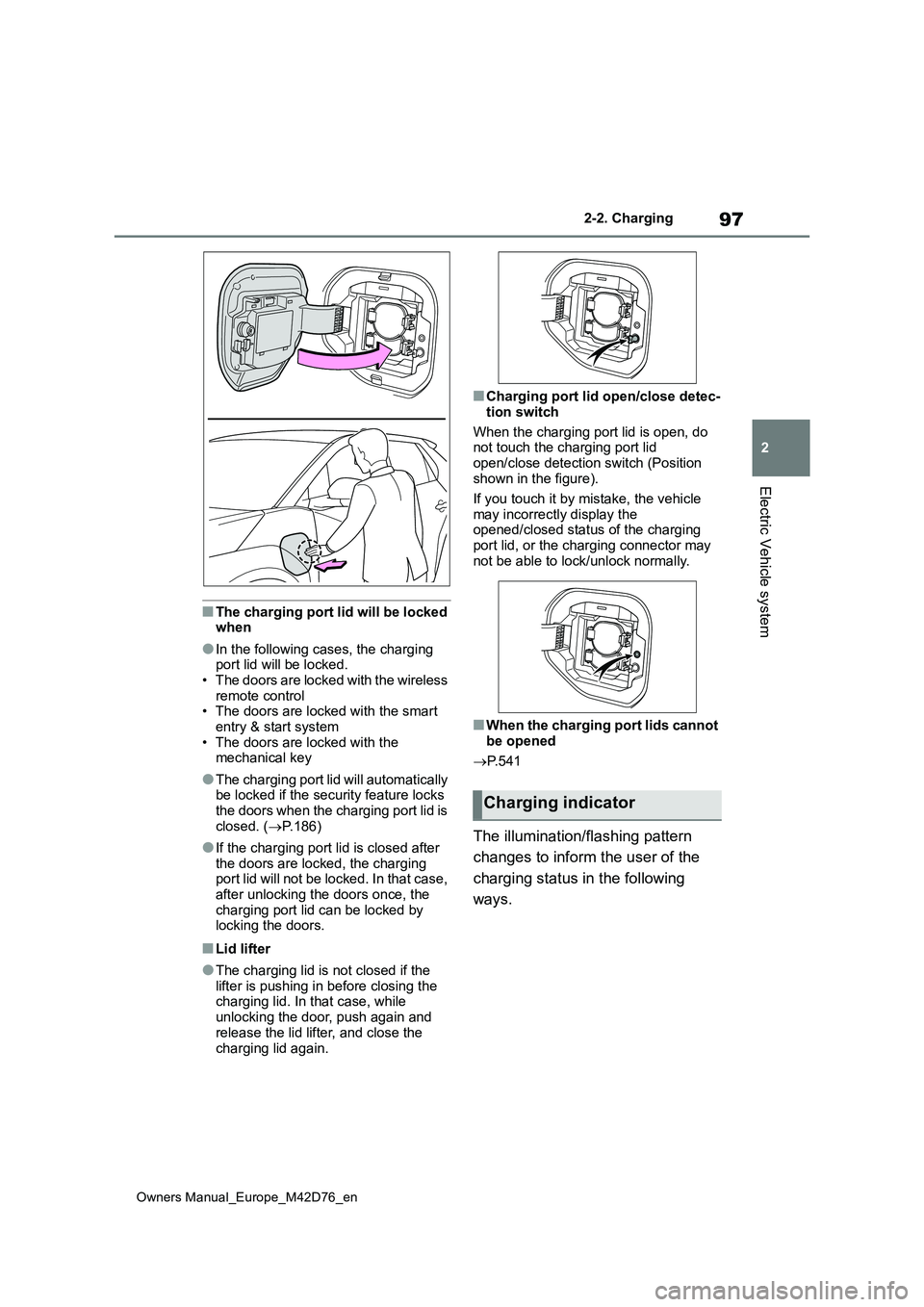
97
2
Owners Manual_Europe_M42D76_en
2-2. Charging
Electric Vehicle system
■The charging port lid will be locked when
●In the following cases, the charging port lid will be locked.• The doors are locked with the wireless
remote control • The doors are locked with the smart entry & start system
• The doors are locked with the mechanical key
●The charging port lid will automatically be locked if the security feature locks the doors when the charging port lid is
closed. ( P.186)
●If the charging port lid is closed after
the doors are locked, the charging port lid will not be locked. In that case, after unlocking the doors once, the
charging port lid can be locked by locking the doors.
■Lid lifter
●The charging lid is not closed if the lifter is pushing in before closing the charging lid. In that case, while
unlocking the door, push again and release the lid lifter, and close the
charging lid again.
■Charging port lid open/close detec-
tion switch
When the charging port lid is open, do not touch the charging port lid
open/close detection switch (Position shown in the figure).
If you touch it by mistake, the vehicle
may incorrectly display the opened/closed status of the charging port lid, or the charging connector may
not be able to lock/unlock normally.
■When the charging port lids cannot
be opened
P. 5 4 1
The illumination/flashing pattern
changes to inform the user of the
charging status in the following
ways.
Charging indicator
Page 100 of 674
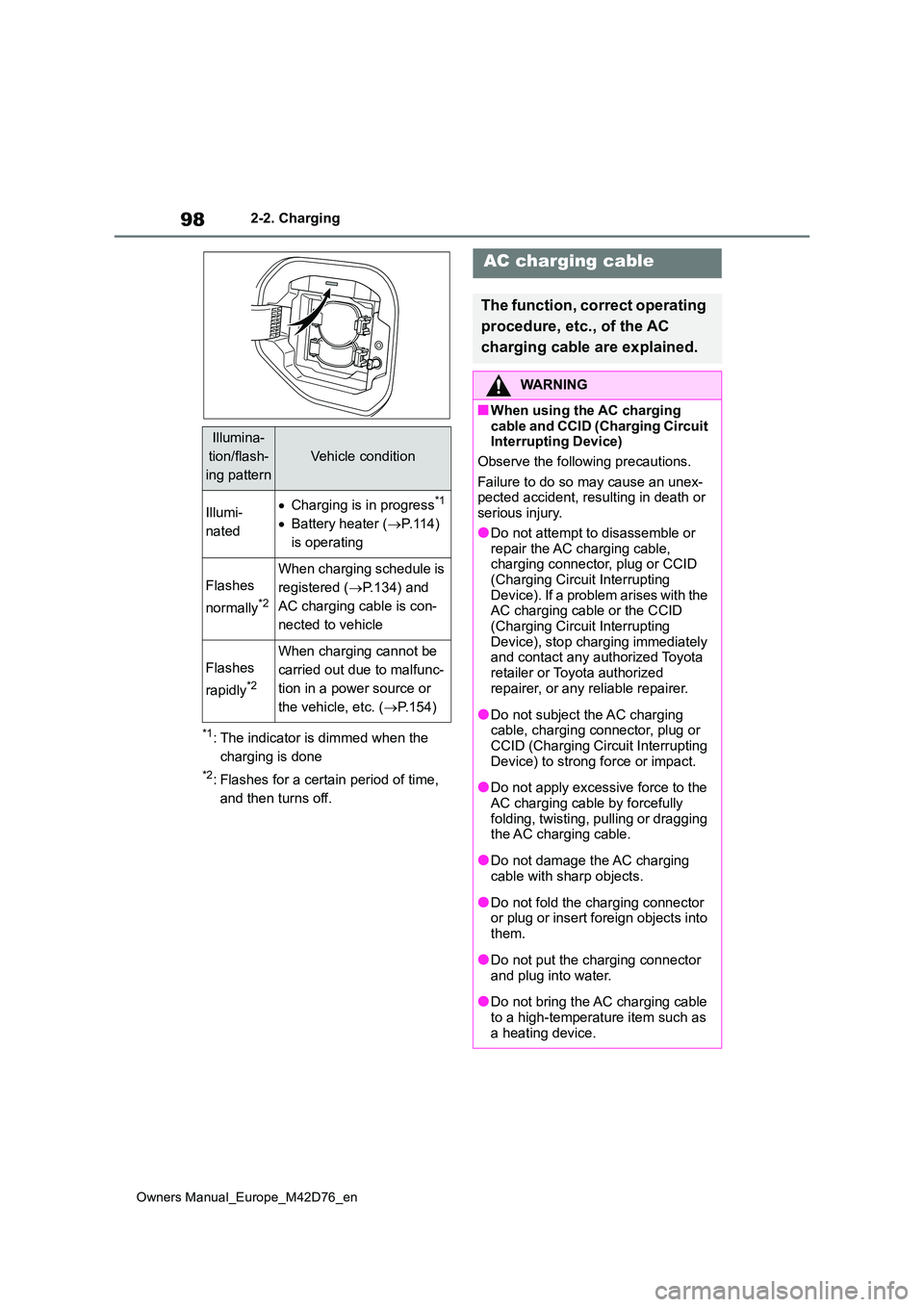
98
Owners Manual_Europe_M42D76_en
2-2. Charging
*1: The indicator is dimmed when the
charging is done
*2: Flashes for a certain period of time,
and then turns off.
Illumina-
tion/flash-
ing pattern
Vehicle condition
Illumi-
nated
Charging is in progress*1
Battery heater (P.114)
is operating
Flashes
normally*2
When charging schedule is
registered ( P.134) and
AC charging cable is con-
nected to vehicle
Flashes
rapidly*2
When charging cannot be
carried out due to malfunc-
tion in a power source or
the vehicle, etc. ( P.154)
AC charging cable
The function, correct operating
procedure, etc., of the AC
charging cable are explained.
WARNING
■When using the AC charging
cable and CCID (Charging Circuit Interrupting Device)
Observe the following precautions.
Failure to do so may cause an unex- pected accident, resulting in death or serious injury.
●Do not attempt to disassemble or repair the AC charging cable, charging connector, plug or CCID
(Charging Circuit Interrupting Device). If a problem arises with the AC charging cable or the CCID
(Charging Circuit Interrupting Device), stop charging immediately and contact any authorized Toyota
retailer or Toyota authorized repairer, or any reliable repairer.
●Do not subject the AC charging cable, charging connector, plug or CCID (Charging Circuit Interrupting
Device) to strong force or impact.
●Do not apply excessive force to the
AC charging cable by forcefully folding, twisting, pulling or dragging the AC charging cable.
●Do not damage the AC charging cable with sharp objects.
●Do not fold the charging connector or plug or insert foreign objects into
them.
●Do not put the charging connector
and plug into water.
●Do not bring the AC charging cable
to a high-temperature item such as a heating device.